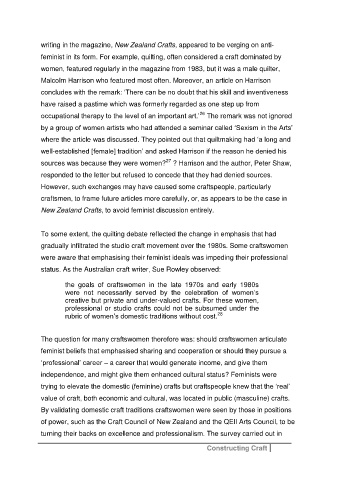Page 257 - Constructing Craft
P. 257
writing in the magazine, New Zealand Crafts, appeared to be verging on anti-
feminist in its form. For example, quilting, often considered a craft dominated by
women, featured regularly in the magazine from 1983, but it was a male quilter,
Malcolm Harrison who featured most often. Moreover, an article on Harrison
concludes with the remark: ‘There can be no doubt that his skill and inventiveness
have raised a pastime which was formerly regarded as one step up from
26
occupational therapy to the level of an important art.’ The remark was not ignored
by a group of women artists who had attended a seminar called ‘Sexism in the Arts’
where the article was discussed. They pointed out that quiltmaking had ‘a long and
well-established [female] tradition’ and asked Harrison if the reason he denied his
27
sources was because they were women? ? Harrison and the author, Peter Shaw,
responded to the letter but refused to concede that they had denied sources.
However, such exchanges may have caused some craftspeople, particularly
craftsmen, to frame future articles more carefully, or, as appears to be the case in
New Zealand Crafts, to avoid feminist discussion entirely.
To some extent, the quilting debate reflected the change in emphasis that had
gradually infiltrated the studio craft movement over the 1980s. Some craftswomen
were aware that emphasising their feminist ideals was impeding their professional
status. As the Australian craft writer, Sue Rowley observed:
the goals of craftswomen in the late 1970s and early 1980s
were not necessarily served by the celebration of women’s
creative but private and under-valued crafts. For these women,
professional or studio crafts could not be subsumed under the
28
rubric of women’s domestic traditions without cost.
The question for many craftswomen therefore was: should craftswomen articulate
feminist beliefs that emphasised sharing and cooperation or should they pursue a
‘professional’ career – a career that would generate income, and give them
independence, and might give them enhanced cultural status? Feminists were
trying to elevate the domestic (feminine) crafts but craftspeople knew that the ‘real’
value of craft, both economic and cultural, was located in public (masculine) crafts.
By validating domestic craft traditions craftswomen were seen by those in positions
of power, such as the Craft Council of New Zealand and the QEII Arts Council, to be
turning their backs on excellence and professionalism. The survey carried out in
Constructing Craft

